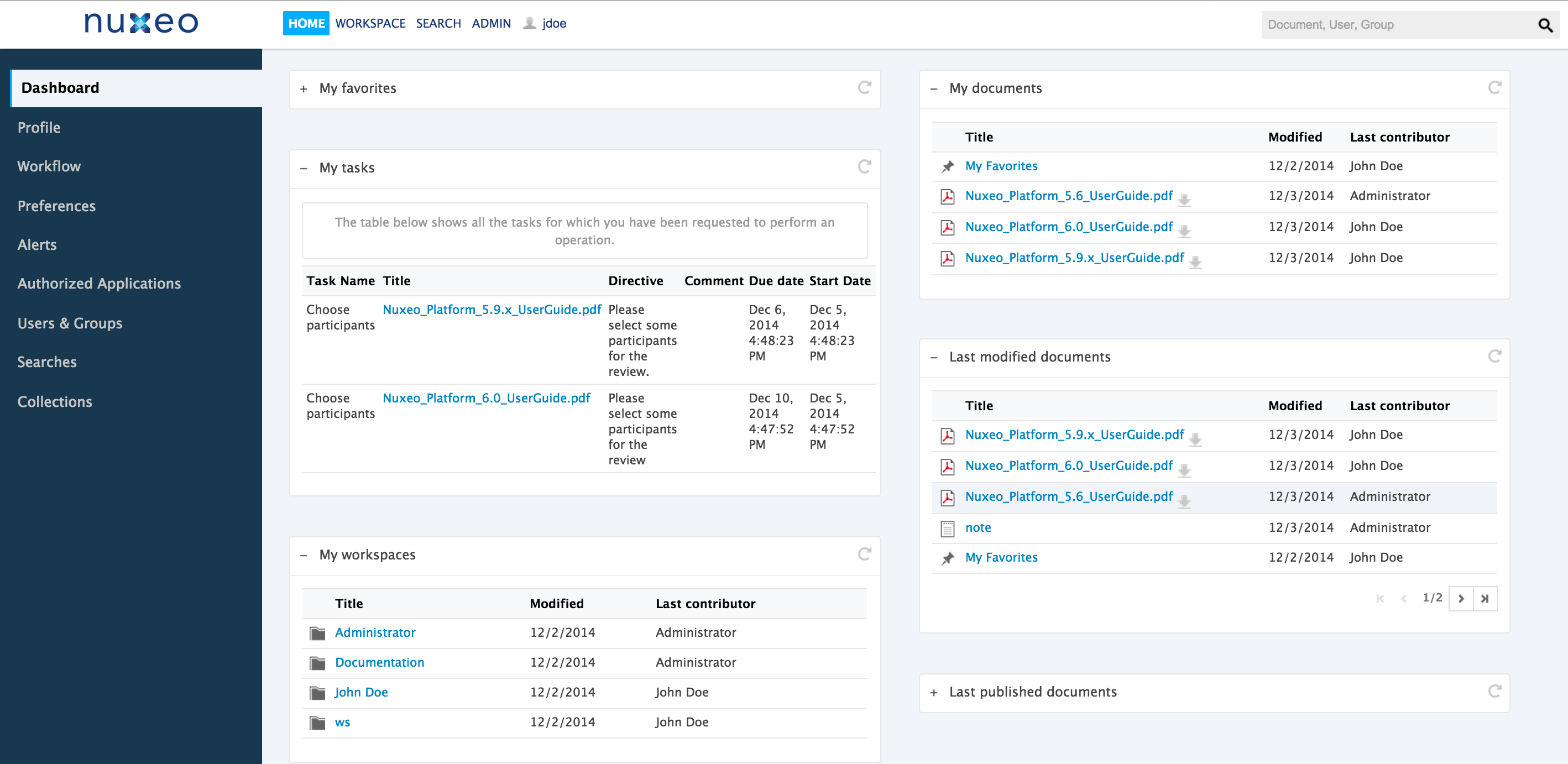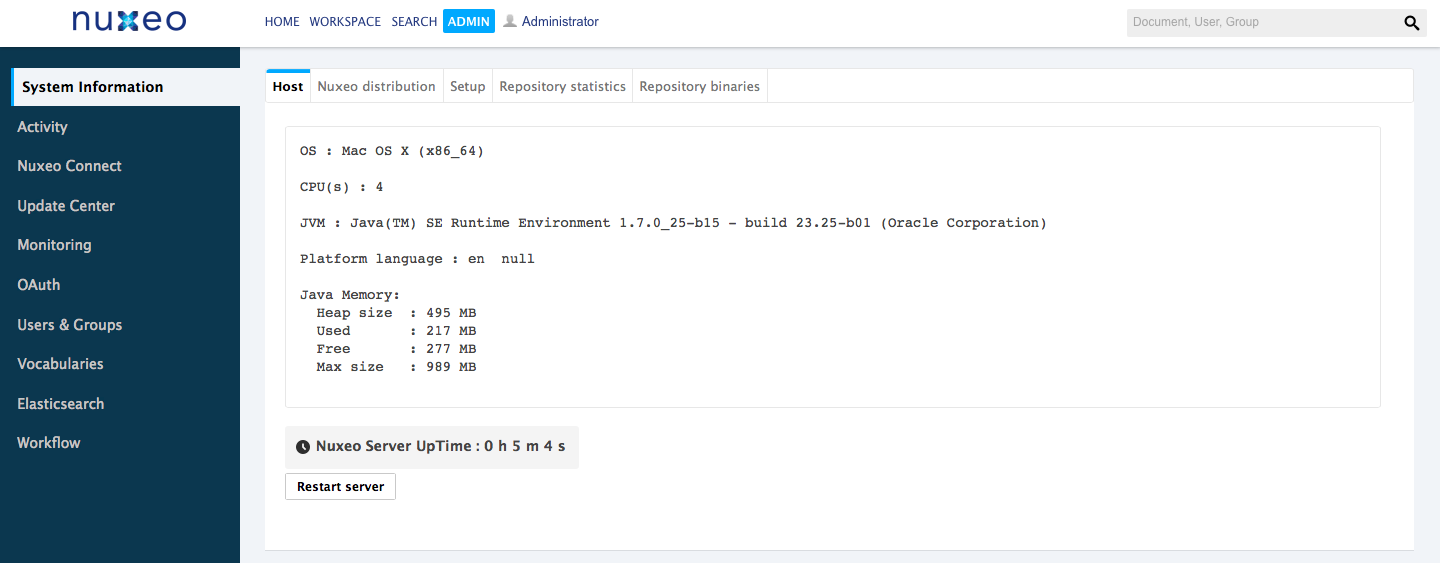The Nuxeo Platform distinguishes collaborative work and content distribution.
The general concept is this: documents are created, edited, possibly approved in workspaces. When finished, they are published in sections. When obsolete, they're unpublished from sections. Actions users can perform on documents are determined by access rights given by spaces managers.
Available spaces
Tabs
Tabs are available on top of the page, that give access to different environments.
- The Home tab is where the user can find all the information that concern him: his dashboard to get a quick access to documents, and that he can customize with internal and external gadgets, the summary of his notification subscriptions, see his profile, etc.


The Workspace tab is the main tab. This is where the majority of user's activity within the Nuxeo Platform will occur since it's where users can work on documents and browse the application domains, workspace, sections, etc.
Users need to have Read access to the root of at least one domain (typically Default domain) to be able to use this tab to browse the application. When users only have access to a workspace or a section, they can only access their dashboard and navigate to their documents from there.


The Admin tab is displayed only to administrators and enables them to manage the application.


Workspaces
Collaborative work takes place in workspaces, where users can create and edit documents. Workspaces are designed to make capture, sharing and editing of documents easier using desktop integration features and comments. In the mean time, documents history and versioning, relations, workflows and alerts enable you to build a coherent and controlled documents structure.
Templates
To help users create the workspaces in which they work, you can create workspaces templates and prepare the structure that will be applied to workspaces used in template-based workspaces.
Sections
When documents are finished and ready, they are published in sections. Traditionally opened to a wider audience than workspaces, sections are dedicated to content distribution and communication and are designed for content consultation. That is why users cannot change documents (edit or move them) in sections: documents published in sections are frozen versions of workspace documents. Publishing is controlled using a workflow, that requires publishing requests to be approved so documents can be seen in sections.
Domains
Sections, workspaces and templates are grouped in domains. A domain can be considered as a mini-application in the Nuxeo Platform or a root in the application. Typically, you can use domains to open the application to two or more very different populations of users. For instance, you can have an "intranet" domain and an "extranet" domain. Domains can be totally independent or not, depending on the access rights you set on each domain.
Access Rights
Access to documents and the actions allowed are determined by access rights. Some users will then be allowed to only read documents, when others will be able to edit documents or to manage spaces and documents.
The available access rights are:
|
Right |
Actions in workspaces |
Actions in sections |
|---|---|---|
|
Read |
Consult content Comment documents Annotate documents Tag documents |
Consult content Comment documents Annotate documents Tag documents |
|
Write |
Create documents Edit documents Add / remove relations Start a workflow
|
Create sections Publish documents Approve document publishing Unpublish documents
|
|
Manage |
Manage access rights Set alerts to other users Apply a preset look on documents Manage deleted documents
|
Manage access rights Set alerts to other users Apply a preset look on documents Manage deleted documents
|
|
Remove |
Delete documents (this permission is included in Write right) The Remove permission is mainly intended to be denied, so as to restrict the actions available to users with "Write" permission. |
Delete sub-sections (this permission is included in Write right) The "Remove" permission is intended to be denied, so as to restrict the actions available to users with "Write" permission. |
|
Can ask for publishing |
|
Submit documents for publishing
|
Access rights are given on folderish spaces (workspaces, sections, templates, domains, but also folders and forum) and are inherited in the sub-spaces.
On a standard Nuxeo Platform application, members are all granted "read" right at the application's root by default.
Groups of Users
To make access rights management easier, you can create groups of users. Instead of giving (or denying) access rights to single users and repeat the same operations several times, you can give several users the same right in one single manipulation by using a group.
Default groups are:
- members: Users in this group are the end-users users of the application.
- power users: Users in this group are the functional administrators of the application. They have a restricted access to the Admin tab, the administration user interface of the Nuxeo Platform, from which they can manage users and groups and edit the vocabularies.
- administrators: Users in this group are the technical administrators of the application. They have access to all the Admin tab features and are in charge of managing the application. Beside the functional administration features, they can edit the application configuration, install packages on the application, consult the application's statistics, restart the server, etc.
Users must be in one of the groups "members" or "administrators" to be able to access content. Power users must be in both the "power users" and "members" groups.
You can create as many groups as needed.